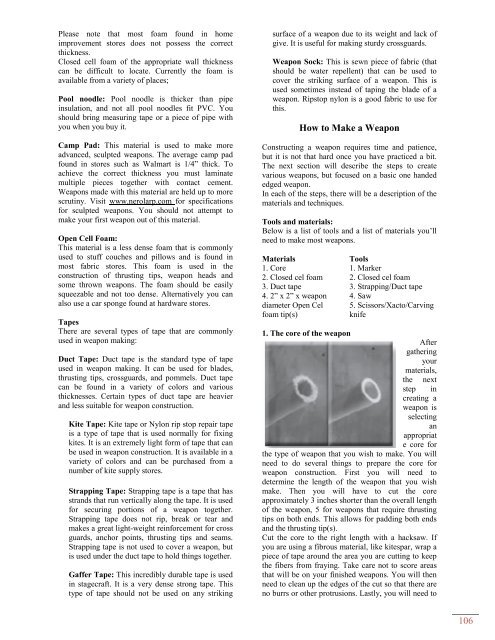Create successful ePaper yourself
Turn your PDF publications into a flip-book with our unique Google optimized e-Paper software.
Please note that most foam found in home<br />
improvement stores does not possess the correct<br />
thickness.<br />
Closed cell foam <strong>of</strong> the appropriate wall thickness<br />
can be difficult to locate. Currently the foam is<br />
available from a variety <strong>of</strong> places;<br />
Pool noodle: Pool noodle is thicker than pipe<br />
insulation, and not all pool noodles fit PVC. You<br />
should bring measuring tape or a piece <strong>of</strong> pipe with<br />
you when you buy it.<br />
Camp Pad: This material is used to make more<br />
advanced, sculpted weapons. The average camp pad<br />
found in stores such as Walmart is 1/4” thick. To<br />
achieve the correct thickness you must laminate<br />
multiple pieces together with contact cement.<br />
Weapons made with this material are held up to more<br />
scrutiny. Visit www.nerolarp.com for specifications<br />
for sculpted weapons. You should not attempt to<br />
make your first weapon out <strong>of</strong> this material.<br />
Open Cell Foam:<br />
This material is a less dense foam that is commonly<br />
used to stuff couches and pillows and is found in<br />
most fabric stores. This foam is used in the<br />
construction <strong>of</strong> thrusting tips, weapon heads and<br />
some thrown weapons. The foam should be easily<br />
squeezable and not too dense. Alternatively you can<br />
also use a car sponge found at hardware stores.<br />
Tapes<br />
There are several types <strong>of</strong> tape that are commonly<br />
used in weapon making:<br />
Duct Tape: Duct tape is the standard type <strong>of</strong> tape<br />
used in weapon making. It can be used for blades,<br />
thrusting tips, crossguards, and pommels. Duct tape<br />
can be found in a variety <strong>of</strong> colors and various<br />
thicknesses. Certain types <strong>of</strong> duct tape are heavier<br />
and less suitable for weapon construction.<br />
Kite Tape: Kite tape or Nylon rip stop repair tape<br />
is a type <strong>of</strong> tape that is used normally for fixing<br />
kites. It is an extremely light form <strong>of</strong> tape that can<br />
be used in weapon construction. It is available in a<br />
variety <strong>of</strong> colors and can be purchased from a<br />
number <strong>of</strong> kite supply stores.<br />
Strapping Tape: Strapping tape is a tape that has<br />
strands that run vertically along the tape. It is used<br />
for securing portions <strong>of</strong> a weapon together.<br />
Strapping tape does not rip, break or tear and<br />
makes a great light-weight reinforcement for cross<br />
guards, anchor points, thrusting tips and seams.<br />
Strapping tape is not used to cover a weapon, but<br />
is used under the duct tape to hold things together.<br />
Gaffer Tape: This incredibly durable tape is used<br />
in stagecraft. It is a very dense strong tape. This<br />
type <strong>of</strong> tape should not be used on any striking<br />
surface <strong>of</strong> a weapon due to its weight and lack <strong>of</strong><br />
give. It is useful for making sturdy crossguards.<br />
Weapon Sock: This is sewn piece <strong>of</strong> fabric (that<br />
should be water repellent) that can be used to<br />
cover the striking surface <strong>of</strong> a weapon. This is<br />
used sometimes instead <strong>of</strong> taping the blade <strong>of</strong> a<br />
weapon. Ripstop nylon is a good fabric to use for<br />
this.<br />
How to Make a Weapon<br />
Constructing a weapon requires time and patience,<br />
but it is not that hard once you have practiced a bit.<br />
The next section will describe the steps to create<br />
various weapons, but focused on a basic one handed<br />
edged weapon.<br />
In each <strong>of</strong> the steps, there will be a description <strong>of</strong> the<br />
materials and techniques.<br />
Tools and materials:<br />
Below is a list <strong>of</strong> tools and a list <strong>of</strong> materials you’ll<br />
need to make most weapons.<br />
Materials Tools<br />
1. Core 1. Marker<br />
2. Closed cel foam 2. Closed cel foam<br />
3. Duct tape 3. Strapping/Duct tape<br />
4. 2” x 2” x weapon 4. Saw<br />
diameter Open Cel 5. Scissors/Xacto/Carving<br />
foam tip(s) knife<br />
1. The core <strong>of</strong> the weapon<br />
After<br />
gathering<br />
your<br />
materials,<br />
the next<br />
step in<br />
creating a<br />
weapon is<br />
selecting<br />
an<br />
appropriat<br />
e core for<br />
the type <strong>of</strong> weapon that you wish to make. You will<br />
need to do several things to prepare the core for<br />
weapon construction. First you will need to<br />
determine the length <strong>of</strong> the weapon that you wish<br />
make. Then you will have to cut the core<br />
approximately 3 inches shorter than the overall length<br />
<strong>of</strong> the weapon, 5 for weapons that require thrusting<br />
tips on both ends. This allows for padding both ends<br />
and the thrusting tip(s).<br />
Cut the core to the right length with a hacksaw. If<br />
you are using a fibrous material, like kitespar, wrap a<br />
piece <strong>of</strong> tape around the area you are cutting to keep<br />
the fibers from fraying. Take care not to score areas<br />
that will be on your finished weapons. You will then<br />
need to clean up the edges <strong>of</strong> the cut so that there are<br />
no burrs or other protrusions. Lastly, you will need to<br />
106


